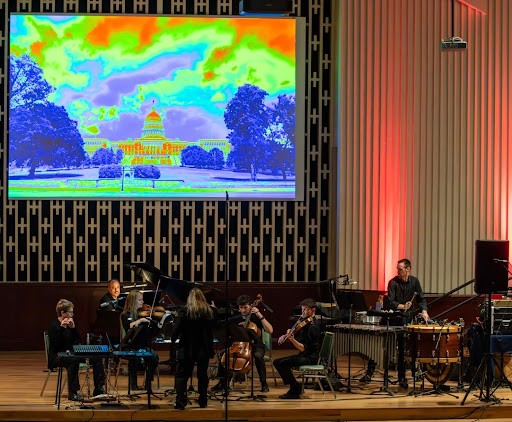by Kevin McLaughlin
 It is one of Cleveland’s persistently good things that outlets for fresh new music — played by some of the area’s best musicians — continue to thrive. On Sunday, April 28, we were reminded of this again at Cleveland Chamber Collective’s presentation of Ty Alan Emerson’s Oath Breaker, a Requiem for chamber ensemble and digital playback at the Pivot Center.
It is one of Cleveland’s persistently good things that outlets for fresh new music — played by some of the area’s best musicians — continue to thrive. On Sunday, April 28, we were reminded of this again at Cleveland Chamber Collective’s presentation of Ty Alan Emerson’s Oath Breaker, a Requiem for chamber ensemble and digital playback at the Pivot Center.
Emerson conducted a distinguished ensemble comprising Linda White, flute, Emily Cornelius, violin, Brian Slawta, viola, Trevor Kazarian, cello, Eric Charnofsky, piano, and Dylan Moffitt, percussion.
Oath Breaker takes the audience on a 60-minute journey of anger, grief, and hope, as a kind of collective PTSD therapy session about the events of January 6 and its subsequent aftermath. The mixture of recorded electronics, live performances, and poetic and prosaic texts helped to conjure in real time the horror of that day.
The decision to use the English language instead of, say, the original Latin of the Mass, made sense as a plain-spoken way to communicate — think Johannes Brahms’ German Requiem. And with a name like Emerson, you could reasonably expect the composer to have good instincts for literary source material. His choices were generally excellent.
The several Shakespeare speeches felt tailor-made for the purpose. Two examples: Richard II’s “Let’s talk of graves and epitaphs” made for a scene-setting Introit, and Lady Ann’s “O, cursed be the hands that made these holes” worked well with its modern double meaning.
The incoming text messages to the former chief of staff, plus a quote from the leader of the Oath Keepers — “We’re not getting through this without a civil war” — made for a powerful Dies Irae. Rapid-fire text messages embedded in a twelve-part fugue evoked requisite “Wrath of God” chaos and violence. But the emotional climax may well have been Queen Elizabeth I’s final benediction during the Libera me:
Grief never ends, but it changes,
It is a passage, not a place to stay.
Grief is not a sign of weakness nor a lack of faith: it is the price of love.
The choice of Requiem as a form struck me as a little forced, and certain texts seemed ill-suited to their positioning within the Mass (Richard II’s “His rash fierce blaze of riot” as an Agnus Dei for example). Still, most of these choices were well considered and aided in the overall sweep.
Musically, the piece maintains internal logic and emotional tautness over the 60-minute span. The visual, musical, and electronic stimuli lent variety, though threatened to dilute focus. There is a lot for the audience to keep track of — the sight and sound of four strings, flutes, and percussion, plus a cornucopia of electronics (MIDI organ and ambient sounds) and a screen for video images, not to mention six pages of texts to read. Yet somehow, it all hangs together, and the overall effect is quite satisfying. Solos — and everyone in the band had one sooner or later — added greatly.
Emerson told me afterward that he had written some of the music five years ago, adding the rest recently. All of it seemed of a piece despite its multitudes. Every passage — whether tonal, multi-tonal, or electronic — was well fitted to the text.
To misquote Dickens, Oath Breaker is an effective telling, not so much of what could be, but of what must never be again.
Photo from the premiere at Disciples Christian Church
Published on ClevelandClassical.com May 1, 2024
Click here for a printable copy of this article


